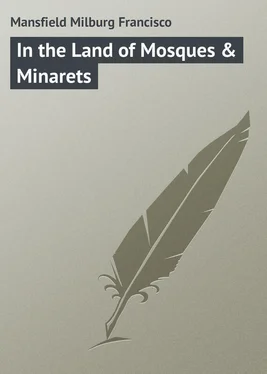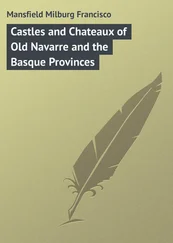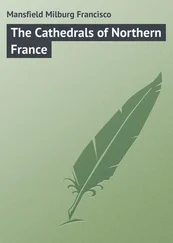Milburg Mansfield - In the Land of Mosques & Minarets
Здесь есть возможность читать онлайн «Milburg Mansfield - In the Land of Mosques & Minarets» — ознакомительный отрывок электронной книги совершенно бесплатно, а после прочтения отрывка купить полную версию. В некоторых случаях можно слушать аудио, скачать через торрент в формате fb2 и присутствует краткое содержание. ISBN: , Жанр: foreign_prose, Путешествия и география, на английском языке. Описание произведения, (предисловие) а так же отзывы посетителей доступны на портале библиотеки ЛибКат.
- Название:In the Land of Mosques & Minarets
- Автор:
- Жанр:
- Год:неизвестен
- ISBN:http://www.gutenberg.org/ebooks/46705
- Рейтинг книги:5 / 5. Голосов: 1
-
Избранное:Добавить в избранное
- Отзывы:
-
Ваша оценка:
- 100
- 1
- 2
- 3
- 4
- 5
In the Land of Mosques & Minarets: краткое содержание, описание и аннотация
Предлагаем к чтению аннотацию, описание, краткое содержание или предисловие (зависит от того, что написал сам автор книги «In the Land of Mosques & Minarets»). Если вы не нашли необходимую информацию о книге — напишите в комментариях, мы постараемся отыскать её.
In the Land of Mosques & Minarets — читать онлайн ознакомительный отрывок
Ниже представлен текст книги, разбитый по страницам. Система сохранения места последней прочитанной страницы, позволяет с удобством читать онлайн бесплатно книгу «In the Land of Mosques & Minarets», без необходимости каждый раз заново искать на чём Вы остановились. Поставьте закладку, и сможете в любой момент перейти на страницу, на которой закончили чтение.
Интервал:
Закладка:
The memory of a Mussulman who has departed this life is not put lightly aside with the rising of the next day’s sun, but a real devotion, if a silent one, goes out towards the departed for many months, and perhaps years, after his corpse is first laid out on its mat of straw in the courtyard of his domicile or before his tent.
At this moment the vague, rigid form compels the devotion of all who were near and dear to him in life. In soft cadence they bewail his death, and prayers of the utmost fervour are sent upward on his behalf. All is calm, solemn, and well-ordered, there is no hysterical excitement, no wailing clamour, and no jealous quarrellings among the heirs.
Above all others one voice cries out a sad voluminous chant. It is the “ Borda ,” the funeral elegy of a departed soul.
An Arab funeral is a solemn affair, though not necessarily imposing. A little group of indeterminate numbers lead off, then four others carrying a litter, covered with a flowing white cloth, on their shoulders. All this is usually in the first hour after sunrise. On a little plateau of desert sand, just above the deep-dug grave, the corpse is finally placed, the company ranged about in a semicircle for one last, long, lingering prayer. The face of the corpse is turned always towards the holy city, Mecca, and when the body has been lowered into its eternal sandy cradle, and covered with a layer of sun-baked clay, and then more sand, three tiny palms are planted above. They soon wither and die, or they live, accordingly as chance favours or not, but the thing is that they be planted.
This is the end; nothing remains but for the women to come along after a decent interval and weep, never by any chance missing a Friday.
CHAPTER VI
ARCHITECTURE OF THE MOSQUES
GOTHIC architecture is expressive of much that a mixed or transitory style lacks, but again the Roman, or Lombard, or the later architecture of the Renaissance, have their own particular cachet quite as recognizable and quite as well defined.
Mohammedan architecture, so different in motif and treatment, is quite as expressive and, in many ways, quite as civilized as the architectural forms of Europe, and possesses in addition a certain feeling which baked clay and plaster suggests better than all other materials. A feeling which is often entirely wanting in cut stone when used to reproduce animal and plant forms.
Saracenic, Assyrian, Persian and Byzantine architectural details are all of them beautiful, if bizarre, but the Mohammedan architecture of the Moors outranks them all for sheer appeal, fantastic and less consistent though it be. Fantastic it is, but often in a simple, suggestive way, depending upon design and proportion rather than profuse decoration. This is why the mosques of Kairouan in Tunisia, or those of Tlemcen in Algeria are even more interesting than the great Mosque of Saint Sophia, or the palace corridors of the Alhambra itself, which are, in fact, but a mixture of several styles. Terra-cotta and baked clay are all right in their way, but their way is the Mohammedan builders’ way, not that of the modern school architects who simulate cut stone in the same plastic products, and build up Turkish baths in palatial twenty-story Broadway hotels with the pagan decorations of ancient Rome, when what they had in mind all the time was the fountained courtyard of a Mohammedan mosque – not by any means a symbolism of paganism. Our new-school architects of the Western world sadly muddle things at times. Moorish arabesques do not mingle well with the palmer’s shells of the Italian Renaissance and the English fan-lights of the brothers Adam.
The word mosque comes properly from the word mesgid , signifying place of adoration. The Italians make of the word, moscheta ; the Spaniards, meschita ; and the French, mosquée . All these variations are met with in North Africa. It is well to recognize them, for both Algeria and Tunisia are more “mixed” in their language and institutions than any other lands yet become affected of twentieth-century tourists. The mixture is perhaps the more likable because of its catholicity. It is certainly more interesting; but school-board and self-taught linguists will need all their wits about them to make the most of the soft, sweet tongue of a desert Arab who lisps first in French, then in Spanish and then in Italian, with perhaps an “ Oh, yes! ” or an “ All right! ” here and there. He modestly reserves his own Arabic for an exclusive harangue among his intimates.
The conventional type of mosque is undoubtedly reminiscent of the Greek basilica, but in every way more amply disposed. The plan herewith is the accepted conventional type of great mosque before it got crowded up in the cities. To-day in most large towns and cities the mosque has been shorn of many of its attributes, leaving only the inner sanctuaries remaining.
The plainness of the exterior of the mosques of North Africa is no indication of the gorgeousness of their interiors. An imposing sobriety of exterior, of all the mosques of Islam in the Moghreb, from Tlemcen to Kairouan, invariably clothes dentelled sculpture and mouldings, fine rugs and hangings, and a labyrinth of architectural fantasies possessed by no other class of civil or religious edifices extant.
The architecture of the mosques of Algeria and Tunisia, as of those of Constantinople and Cairo, is the apotheosis of a mysterious symbolism, at which the infidel can but wonder and speculate. He will never understand it, at least he will never feel it as does the Mussulman himself. It is unfortunate that we outsiders are thought of as unbelievers, but so it is. One does not forget that even twentieth-century Arab gamins at Suez and Port Saïd revile the Christian with their guttural:
“Ya Nasrani
Kalb awani!”
This venerable abuse means nothing more or less than:
“O Nazarene
O dog obscene!”
This comes down from tradition, for the same thing is recounted in Percy’s “Reliques.” There, in a certain anecdote, a knight calls his Mussulman opponent “ unchristian hound ,” to which the retort courteous was given as, “christen dogge.”
Of all the dainty features of a Moorish mosque none appeals to the artist as does the minaret. Minaret is the Arab name for a chandelier, lantern, signal fire, and finally the slim, graceful tower of purely Arab origin. Properly speaking it is in the application to the Mussulman place of worship, the mosque, that we know the minaret in its most poetic form. In its architectural sense, however, it is that slim, graceful, arrow-like tower which is so frequently a component part of a Moorish or Byzantine structure.
The Hebrews had a similar word for a tower which performed similar functions — menorah ; and the Chaldeans the word menora ; while, finally, the Syrians adopted menortho . Of the exotic origin of the word there is no doubt, but a minaret is first of all something more than a mere tower. It must be of special proportions, and it must be an adjunct to a more pretentious structure. Never is a minaret a thing apart.
For a comparison between the Byzantine minaret and that born of the ingenuity of the Moorish builder, the words of Théophile Gautier must be accepted as final: “The minarets of Saint Sophia (Constantinople) have not the elegance nor sveltesse of those of the Moor.”
The minaret of the mosque of the Sultan Kalaûn at Cairo is perhaps the most splendid of all contemporary works. Its height approximates two hundred feet, and though the mosque itself is ruined, its firm, square minaret, brilliant with all the fantasy of the best of Mussulman art, is to-day quite the most splendid example of its class above ground.
Читать дальшеИнтервал:
Закладка:
Похожие книги на «In the Land of Mosques & Minarets»
Представляем Вашему вниманию похожие книги на «In the Land of Mosques & Minarets» списком для выбора. Мы отобрали схожую по названию и смыслу литературу в надежде предоставить читателям больше вариантов отыскать новые, интересные, ещё непрочитанные произведения.
Обсуждение, отзывы о книге «In the Land of Mosques & Minarets» и просто собственные мнения читателей. Оставьте ваши комментарии, напишите, что Вы думаете о произведении, его смысле или главных героях. Укажите что конкретно понравилось, а что нет, и почему Вы так считаете.












